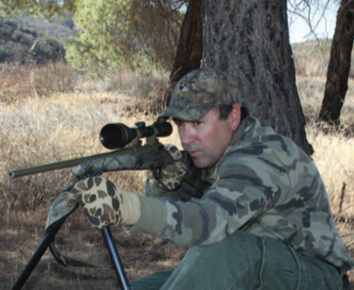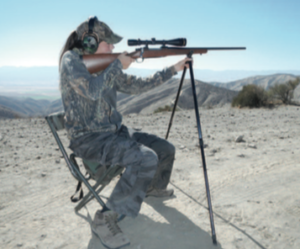
BY TIM HOVEY
I was sitting to the left of the hunter blowing the predator call. The coyote had come in from my side and stopped broadside out at 100 yards — an easy shot for a scoped rifle. The shooter, who shall remain nameless, had swung his set up into position while the predator had dropped from view during the approach. I watched, anticipating the report of the rifle at the easy chip shot. Seconds passed and then the shot came. Dirt kicked up four inches below the coyote and in the blink of an eye, he was gone.
Swearing and a seriously desperate and useless second shot followed the first and then the desert was quiet… except for the sound of me laughing.
Misses will always occur, but in this instance, I knew the reason this hunter had missed. He had taken exactly two shots in the span of two months and both had been misses. As with anything, if you don’t practice, you won’t improve.
It doesn’t matter what activity you participate in, at the core of continued participation in that activity is the human urge to get better. The same goes for the shooting sports. When I head out to hunt, I take great
pride in knowing that my off-season target sessions will pay dividends

for me during the pursuit of game later in the year. And all that preparation starts with practice.
In my opinion, shooting off the steady bench at a shooting range is where you go to sight in your firearm and get used to the specifics of your rifle. Using a heavy rifle sled or steady bags, shooters can dial in their scope, test out different ammunition, and of course, test your accuracy. If I’ve changed out my scopes or am shooting a new rig for the first time, this is usually where I start.
However, out in the field is where I sharpen my marksman skills by actually shooting like I hunt. I focus on three main shooting objectives: quick target acquisition, obtaining a solid sight picture and performing a smooth trigger squeeze. My focus is to hone these three shooting techniques and to seamlessly connect them so that it almost feels like one action.
I believe one of the dividers between hunting success and failure is quick target acquisition. If I see someone mount their rifle and have to bob their head or have to make several adjustments to see through the scope well, I know they haven’t spent a lot of time shooting that particular firearm. With repeated mounting and shooting, shooters will develop muscle memory and be able to instantly see clearly through their optics.
Seeing clearly through a scope is one thing. Finding your target through that scope is entirely something else. With practice, you should be able to spot your target, mount your rifle and almost instantly find your target in your scope. This step is where seconds really count during the hunt. If it takes you more than a few seconds to find your target through the scope, the shot opportunity may pass. Practicing quick target acquisition during the offseason should provide you more shot opportunities during the hunt.
Try picking a landmark near your target, using this item to zero in on. I’ll often find a structure and orient my target to that item. Once I raise the rifle, I’ll look for the target and the structure, pinpointing my intended target quickly. I also aim with both my eyes open, aiding in quick target acquisition.
Establishing a good sight picture just before you squeeze the trigger is essential for hunting accuracy. A sight picture is simply the image your brain detects at the instance you squeeze the trigger. As you calm yourself and adjust the firearm so that the crosshairs are overlapped on the target, your brain perceives a snapshot of that image. When all is in alignment, the shot should be taken. I’ll frequently look through the scope and without a trigger squeeze just say to myself, “Now,” indicating a trigger pull when I have an adequate sight picture. Repeating this step over and over again, without ever firing a shot helps me get used to what my sight picture should look like.
The mechanics of squeezing the trigger are simple. However, to consistently and smoothly perform this action involves shooting practice, focusing on muscle memory of the squeeze.
To accurately hit what you’re aiming at after you fire the shot involves removing all unnecessary movement, like pulling or jerking the trigger. Often, a quick trigger pull, or a jerking of the trigger will pull the firearm to the right a fraction for right hander’s, sending the shot high and right of the intended target. A calm trigger squeeze shouldn’t move the firearm right or left, but instead be a breaking pressure backwards until the trigger breaks. This will assure that shot placement is not impacted by the trigger squeeze at all.
Performing these three shooting steps together with practice can greatly improve your accuracy and your ability to acquire your target quickly. Good shot placement will also improve as your familiarity with the proper sight picture improves. These exercises will also increase your shooting confidence and make you a better hunter in the field.
If you’re looking to perform better during hunting season, practicing your shooting will go a long way in helping you fill your game bag or your freezer. Just like with any activity, the more you do it, the better you’ll get; and when you’re talking about hunting which involves a wild component, good shooters will see benefits if they’ve practiced their craft in the offseason.



